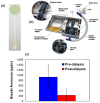Miniaturized Bio-and Chemical-Sensors for Point-of-Care Monitoring of Chronic Kidney Diseases
- PMID: 29565315
- PMCID: PMC5948530
- DOI: 10.3390/s18040942
Miniaturized Bio-and Chemical-Sensors for Point-of-Care Monitoring of Chronic Kidney Diseases
Abstract
This review reports the latest achievements in point-of-care (POC) sensor technologies for the monitoring of ammonia, creatinine and urea in patients suffering of chronic kidney diseases (CKDs). Abnormal levels of these nitrogen biomarkers are found in the physiological fluids, such as blood, urine and sweat, of CKD patients. Delocalized at-home monitoring of CKD biomarkers via integration of miniaturized, portable, and low cost chemical- and bio-sensors in POC devices, is an emerging approach to improve patients' health monitoring and life quality. The successful monitoring of CKD biomarkers, performed on the different body fluids by means of sensors having strict requirements in term of size, cost, large-scale production capacity, response time and simple operation procedures for use in POC devices, is reported and discussed.
Keywords: POC testing devices; biosensors; chemical sensors; kidney disease.
Conflict of interest statement
The authors declare no conflict of interest.
Figures











Similar articles
-
Electrochemical Creatinine (Bio)Sensors for Point-of-Care Diagnosis of Renal Malfunction and Chronic Kidney Disorders.Diagnostics (Basel). 2023 May 13;13(10):1737. doi: 10.3390/diagnostics13101737. Diagnostics (Basel). 2023. PMID: 37238220 Free PMC article. Review.
-
Modern creatinine (Bio)sensing: Challenges of point-of-care platforms.Biosens Bioelectron. 2019 Apr 1;130:110-124. doi: 10.1016/j.bios.2019.01.048. Epub 2019 Jan 30. Biosens Bioelectron. 2019. PMID: 30731344 Review.
-
Recent Advances in Portable Biosensors for Biomarker Detection in Body Fluids.Biosensors (Basel). 2020 Sep 18;10(9):127. doi: 10.3390/bios10090127. Biosensors (Basel). 2020. PMID: 32961853 Free PMC article. Review.
-
A review of biosensor technologies for blood biomarkers toward monitoring cardiovascular diseases at the point-of-care.Biosens Bioelectron. 2021 Jan 1;171:112621. doi: 10.1016/j.bios.2020.112621. Epub 2020 Sep 18. Biosens Bioelectron. 2021. PMID: 33120234 Review.
-
[Department of microbiosensing system using micromachine techniques].Rinsho Byori. 1999 Dec;47(12):1105-12. Rinsho Byori. 1999. PMID: 10639819 Review. Japanese.
Cited by
-
Integration of an Aerosol-Assisted Deposition Technique for the Deposition of Functional Biomaterials Applied to the Fabrication of Miniaturised Ion Sensors.Nanomaterials (Basel). 2021 Apr 7;11(4):938. doi: 10.3390/nano11040938. Nanomaterials (Basel). 2021. PMID: 33916937 Free PMC article.
-
Multitargeted interventions to reduce dialysis-induced systemic stress.Clin Kidney J. 2021 Dec 27;14(Suppl 4):i72-i84. doi: 10.1093/ckj/sfab192. eCollection 2021 Dec. Clin Kidney J. 2021. PMID: 34987787 Free PMC article. Review.
-
Newer Point-of-Care Biosensors Are Expected to Permit Early Detection and Better Management of Acute and CKD.Kidney Int Rep. 2018 Jul 7;3(5):1025-1026. doi: 10.1016/j.ekir.2018.07.007. eCollection 2018 Sep. Kidney Int Rep. 2018. PMID: 30197967 Free PMC article. No abstract available.
-
Solution Blowing Spinning Technology towards Green Development of Urea Sensor Nanofibers Immobilized with Hydrazone Probe.Polymers (Basel). 2021 Feb 11;13(4):531. doi: 10.3390/polym13040531. Polymers (Basel). 2021. PMID: 33670291 Free PMC article.
-
Passive sweat collection and colorimetric analysis of biomarkers relevant to kidney disorders using a soft microfluidic system.Lab Chip. 2019 Apr 23;19(9):1545-1555. doi: 10.1039/c9lc00103d. Lab Chip. 2019. PMID: 30912557 Free PMC article.
References
-
- Da Silva E.T.S.G., Souto E.P., Barragan J.T.C., Giarola F., Ana C.M., Kubota L.T. Electrochemical biosensors in point-of-care devices: Recent advances and future trends. ChemElectroChem. 2017;4:778–794. doi: 10.1002/celc.201600758. - DOI
Publication types
MeSH terms
Substances
LinkOut - more resources
Full Text Sources
Other Literature Sources
Medical

